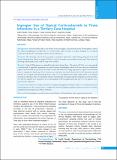Please use this identifier to cite or link to this item:
https://hdl.handle.net/20.500.14356/1049Full metadata record
| DC Field | Value | Language |
|---|---|---|
| dc.contributor.author | Paudel, Sushil | - |
| dc.contributor.author | Parajuli, Niraj | - |
| dc.contributor.author | Dahal, Sudip Chandra | - |
| dc.contributor.author | Paudel, Sudarshan | - |
| dc.date.accessioned | 2023-04-20T09:56:13Z | - |
| dc.date.available | 2023-04-20T09:56:13Z | - |
| dc.date.issued | 2021 | - |
| dc.identifier.citation | PaudelS., ParajuliN., DahalS. C., & PaudelS. (2021). Improper Use of Topical Corticosteroids in Tinea Infections in a Tertiary Care Hospital. Journal of Nepal Health Research Council, 19(1), 71-75. https://doi.org/10.33314/jnhrc.v19i1.3105 | en_US |
| dc.identifier.issn | Print ISSN: 1727-5482; Online ISSN: 1999-6217 | - |
| dc.identifier.uri | http://103.69.126.140:8080/handle/20.500.14356/1049 | - |
| dc.description | Original Article | en_US |
| dc.description.abstract | Abstract Background: Steroid-modified tinea, also known as tinea incognito, is an infection by the dermatophytes, where the clinical morphology is modified due to corticosteroids, either systemic or topical. Rampant use of topical corticosteroids has led to increasing recurrence in tinea infections. Methods: All consenting cases of tinea presenting to outpatient department of dermatology department of Civil Service Hospital from March to August 2020 for a total of 6 months were included in this study. Tinea infection involving only the palms, soles, nails or scalp were excluded. Results: A total of 200 patients were included in this study. Among these, 175 patients (87.5%) were using topical corticosteroids. A significant association was noted between dermatophyte infection of more than one month and topical corticosteroids use (p<0.05). This study revealed that males were using super-potent topical corticosteroids more as compared to females (p<0.05). Moreover, no association was noted between the level of education attained and the use of topical corticosteroids (p=0.91). Only 25 (12%) patients were either using correct or no topical medications during the time of consultation with the dermatologist. Among the patients using topical corticosteroids, 155 (88.6%) patients were using them on recommendation of the local pharmacist and only 2 (1.2%) patients were prescribed by a physician. Conclusions: In short, use of topical steroids was rampant among patients with tinea whilst 77.5% patients procured steroid topicals over-the-counter. Hence, a tougher law and strict regulatory guidelines deemed necessary to curb the unauthorized and rampant sale of these medicines. Keywords: Dermatophytes; over-the-counter; steroid misuse; self-medications; tinea; topical corticosteroid | en_US |
| dc.language.iso | en | en_US |
| dc.publisher | Nepal Health Research Council | en_US |
| dc.relation.ispartofseries | Jan-March, 2021;3105 | - |
| dc.subject | Dermatophytes | en_US |
| dc.subject | Over-the-counter | en_US |
| dc.subject | Steroid misuse | en_US |
| dc.subject | Self-medications | en_US |
| dc.subject | Tinea | en_US |
| dc.subject | Opical corticosteroid | en_US |
| dc.title | Improper Use of Topical Corticosteroids in Tinea Infections in a Tertiary Care Hospital | en_US |
| dc.type | Journal Article | en_US |
| local.journal.category | Original Article | - |
| Appears in Collections: | Vol. 19 No. 1 (2021): Vol. 19 No. 1 Issue 50 Jan-Mar 2021 | |
Files in This Item:
| File | Description | Size | Format | |
|---|---|---|---|---|
| 3105-Manuscript-21552-1-10-20210425.pdf | Fulltext Article. | 240.23 kB | Adobe PDF |  View/Open |
Items in DSpace are protected by copyright, with all rights reserved, unless otherwise indicated.
